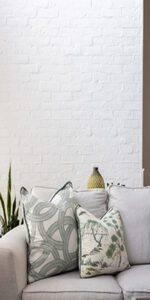White-Washed: Working with White
As a decorator, I try not to play favourites. But I’ll admit, white ranks right up there, the top choice of modernists, minimalists, purists and myself. (It’s no coincidence that my company is called Simply White Interiors!)
White is bright and fresh; it can make a room feel infinitely bigger and cleaner; it goes with literally everything. But at the same time, an all-white palette can be challenging to create and maintain. Here are some tips to do right by white.
Choose your whites wisely.
White is white, right? Actually, that statement couldn’t be more wrong. There are about as many different tints of white as there are colours in the rainbow. White can be tinted with yellow, red, blue, green, purple, or any mixture of these to make thousands of hues. You don’t have to choose just one. In fact, layering whites is a great strategy to create interest and bring depth to a monochromatic interior. However, you should stick to the same “temperature” of your white.
Warm colours lean to the yellow and red side of the colour spectrum, while cool colours tend toward greens and blues. Your whites, in all their variations, can also be either warm or cool. Crossing that boundary will compromise the all-white effect, creating a contrast that will make some whites show their undertones more than you’d like.
Designer Finds: Some of my favourite whites include:
•OC – 117 Simply White
•OC – 65 Chantilly Lace
•CC – 30 Oxford White
•OC – 17 White Dove
No colour? No problem.
Every stylish room needs contrast and interest. So, how do you achieve that, if you can’t lean into colour? Texture can make a flat, white room come to life. Choose materials that have different finishes: grainy wood, rough stone, smooth tile, glossy cabinets, matte walls, textiles that are silky, velvety, coarse – the options are endless. Once you have a good variety of textures and scales, layer them to create visual interest. Don’t forget that pattern can play a role in a white interior, too.
 Now, this might seem counterintuitive, but a bit of black has a place in every white interior. As the polar opposite and equal neutral, it brings balance to a white room, punctuates focal points and highlights architectural features. Imagine a black fireplace, black window and door casings, or black-painted floors throughout an otherwise white home. If you want the impact without the commitment, consider upgrading to black light fixtures and hardware, accessories and art. The secret is to use it sparingly.
Now, this might seem counterintuitive, but a bit of black has a place in every white interior. As the polar opposite and equal neutral, it brings balance to a white room, punctuates focal points and highlights architectural features. Imagine a black fireplace, black window and door casings, or black-painted floors throughout an otherwise white home. If you want the impact without the commitment, consider upgrading to black light fixtures and hardware, accessories and art. The secret is to use it sparingly.
Wearable whites.
A home is meant to be lived in and enjoyed, so don’t treat your white walls, furniture and floor coverings as “untouchables.” It’s a home, not a museum. If you’re concerned about the durability and longevity of your whites, worry not – you’ve got options. Designers and manufacturers are equally aware of the popularity and difficulties of white, and they’ve come a long way in creating hard-wearing, well-washing and withstanding whites that can handle muddy paws, sticky fingers and the occasional spill.
When choosing white furniture and floor coverings, consider their context. If it’s seating in a family room, faux leather is wipeable, microsuede is washable and denim is, well, denim – need I say more? These are all great options in areas where people may be eating, drinking, or flopping down without washing hands or changing clothes before doing so. And removable washable slipcovers are a great option to carry you through those terribly messy years of kids, pets and whatever else is landing on your new sofa and chairs.
 I’m not sure who loves white more – my clients, or me as the designer. White offers endless options to bring bold trends and one-of-a-kind personality to each interior. Every white room can be truly unique, despite the wide popularity of this colour palette.
I’m not sure who loves white more – my clients, or me as the designer. White offers endless options to bring bold trends and one-of-a-kind personality to each interior. Every white room can be truly unique, despite the wide popularity of this colour palette.
Bren Petrunick is the creative founder of award winning Simply White Interiors.
swi.design @simplywhite




